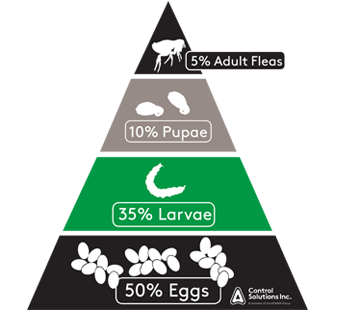Adult fleas are parasites of warm-blooded animals such as cats, dogs, and humans. Under most situations, fleas will complete their life cycle within three to five weeks, passing through four life stages: egg, larva, pupa, and an adult stage.
Adult fleas are irritating, blood feeding insects that can cause irritating, itchy bites and in extreme cases can remove enough blood from animals to be anemic or exsanguinating them which can be deadly. The reality of the situation is, in a population, the actively biting adults only make up about 5% of the total population.

An adult female flea lays 4 to 6 eggs after each blood meal, and she can usually lay several hundred during her lifetime. The light-colored eggs are deposited while on the host. Eggs are not sticky, so they fall off the animal and are frequently found in the host’s bedding, carpets, sofas, and crevices in the structure near where the host spends time. The eggs normally hatch within 36 hours, it can be delayed by up to 10 days, depending on environmental conditions. Pesticides cannot penetrate the egg shell.
Flea larvae are slender, white, legless and between 1/10 and 1/5-inch long. They are free living and feed on debris found in their environment, with their favorite food being partially digested blood produced by adult fleas. The larval stage usually lasts between 5 and 11 days but can be extended up to 3 weeks if conditions are not favorable. Flea larvae are very sensitive to heat and desiccation (drying out), and therefore thrive in shaded, protected areas.
Flea pupae spin a silken cocoon that is usually covered with sand, dirt and other debris found in the environment. Pupae are typically located in similar areas to the larvae. Adult fleas will emerge from the pupal stage after 5 to 10 days. If a host is not present, the flea can remain in the pupal stage for up to 4 months. Emergence from the pupal stage is triggered by a host’s body heat, movement and exhaled carbon dioxide; if no host is present these will not trigger the flea to emerge. This stage is the most resistant to pesticides and desiccation, so any application type will not affect this stage.
Fleas are extremely adaptable insects and flea populations can exist inside homes for extended periods of time without a host animal due to the protective pupal stage.
Flea Management Tips

Remember, insecticides only affect the larva and adult stages, so the insecticide must be left undisturbed until the fleas reach one of these stages of their life cycle. Insect growth regulators are the most important addition in a pes management service – by breaking the life cycle you can affect the next generation of fleas, stopping their development.
You may continue to notice flea activity after treatment because this insecticide has a delayed effect on emerging fleas. THIS DOES NOT MEAN THE TREATMENT ISN’T WORKING! It may take up to three weeks before all activity ceases.
REMEMBER